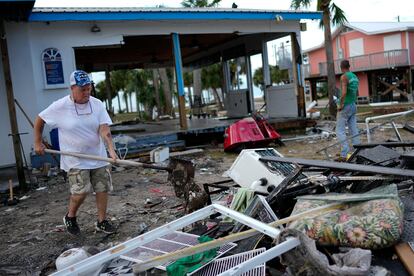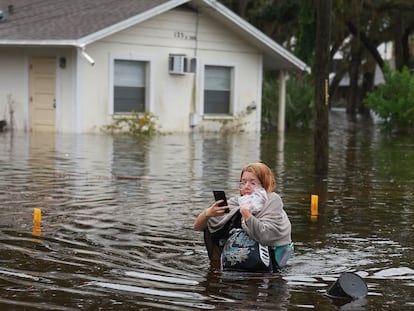Residents return to find homes gone and towns devastated in path of Idalia
Idalia first hit Florida as a hurricane and then moved on to spark flooding in Georgia and South Carolina and heavy rains in North Carolina before moving out to sea Thursday

Hurricanes and tropical storms are nothing new in the South, but the sheer magnitude of damage from Idalia shocked Desmond Roberson as he toured what as left of his Georgia neighborhood.
Roberson took a drive through Valdosta on Thursday with a friend to check out damage after the storm, which first hit Florida as a hurricane and then weakened into a tropical storm as it made its way north, ripped through the town of 55,000.
On one street, he said, a tree had fallen on nearly every house. Roads remained blocked by tree trunks and downed power lines, and traffic lights were still blacked out at major intersections.
“It’s a maze,” Roberson said. “I had to turn around three times, just because roads were blocked off.”
The storm had 90 mph (145 kph) winds when it made a direct hit on Valdosta on Wednesday, Georgia Gov. Brian Kemp said.
“We’re fortunate this storm was a narrow one, and it was fast moving and didn’t sit on us,” Kemp told a news conference Thursday in Atlanta. “But if you were in the path, it was devastating. And we’re responding that way.”
One Georgia resident was killed when a tree fell on him as he tried to clear another tree from a road.
The storm first made landfall Wednesday in Florida, where it razed homes and downed power poles. It then swung northeast, slamming Georgia, flooding many of South Carolina’s beaches and sending seawater into the streets of downtown Charleston. In North Carolina, it poured more than 9 inches (23 centimeters) of rain on Whiteville, which flooded downtown buildings.
Thousands of utility line workers rushed to restore power in Florida, but nearly 95,000 customers were still without electricity Friday morning.
The storm had moved away from the U.S. coast early Thursday and spun out into the Atlantic, still packing winds of 60 mph (97 kph) on Friday. It could hit Bermuda on Saturday, bringing heavy rainfall and potential flash flooding to the island, according to the U.S. National Hurricane Center.
Meanwhile, residents along the path of destruction returned to pick through piles of rubble that used to be homes.
James Nobles returned to the tiny town of Horseshoe Beach in Florida’s remote Big Bend to find his home had survived the battering winds and rain, but many of his neighbors weren’t as fortunate.
“The town, I mean, it’s devastated,” Nobles said. “It’s probably 50 or 60 homes here, totally destroyed. I’m a lucky one.”
Residents, most of whom evacuated inland during the storm, helped each other clear debris or collect belongings — high school trophies, photos, records, china. They frequently stopped to hug amid tears. Six-foot-high (1.8-meter-high) watermarks stained walls still standing, marking the extent of the storm surge.
Florida Gov. Ron DeSantis toured the area with his wife, Casey, and federal emergency officials.
“I’ve seen a lot of really heartbreaking damage,” he said, noting a church that had been swamped by more than 4 feet (1.2 meters) of water.
Tammy Bryan, a member of the severely damaged First Baptist Church, said Horseshoe Beach residents consider themselves a family, one largely anchored by the church.
“It’s a breath of fresh air here,” Bryan said. “It’s beautiful sunsets, beautiful sunrises. We have all of old Florida right here. And today we feel like it’s been taken away.”
Florida officials said there was one hurricane-related death in the Gainesville area, but didn’t release any details.
But unlike previous storms, Idalia didn’t wreak havoc on major urban centers. It provided only glancing blows to Tampa Bay and other more populated areas, DeSantis noted. In contrast, Hurricane Ian last year hit the heavily populated Fort Myers area, leaving 149 dead in the state.
President Joe Biden spoke to DeSantis and promised whatever federal aid is available. Biden also announced that he will go to Florida on Saturday to see the damage himself.
The president used a news conference at the Federal Emergency Management Agency’s headquarters to send a message to Congress, especially those lawmakers who are balking at his request for $12 billion in emergency funding to respond to natural disasters.
“We need this disaster relief request met, and we need it in September” after Congress returns from recess, said Biden, who had pizza delivered to FEMA employees who have been working around the clock on Idalia and the devastating wildfires on Maui, Hawaii.
Sign up for our weekly newsletter to get more English-language news coverage from EL PAÍS USA Edition
Tu suscripción se está usando en otro dispositivo
¿Quieres añadir otro usuario a tu suscripción?
Si continúas leyendo en este dispositivo, no se podrá leer en el otro.
FlechaTu suscripción se está usando en otro dispositivo y solo puedes acceder a EL PAÍS desde un dispositivo a la vez.
Si quieres compartir tu cuenta, cambia tu suscripción a la modalidad Premium, así podrás añadir otro usuario. Cada uno accederá con su propia cuenta de email, lo que os permitirá personalizar vuestra experiencia en EL PAÍS.
¿Tienes una suscripción de empresa? Accede aquí para contratar más cuentas.
En el caso de no saber quién está usando tu cuenta, te recomendamos cambiar tu contraseña aquí.
Si decides continuar compartiendo tu cuenta, este mensaje se mostrará en tu dispositivo y en el de la otra persona que está usando tu cuenta de forma indefinida, afectando a tu experiencia de lectura. Puedes consultar aquí los términos y condiciones de la suscripción digital.
More information
Archived In
Últimas noticias
Chris Martin, Taylor Swift, Elijah Wood and other famous wedding ‘crashers’
‘How does it feel to be a failure?’: Elizabeth Berkley’s journey from ‘Showgirls’ ridicule to vindication
The story of the Málaga virus: The code that haunted Google’s cybersecurity center director for 30 years
The impact of Ecuador’s mega-prison: A polluted river, cleared forests and military checkpoints
Most viewed
- Christian Louboutin: ‘Young people don’t want to be like their parents. And if their parents wear sneakers, they’re going to look for something else’
- The low-cost creative revolution: How technology is making art accessible to everyone
- Liset Menéndez de la Prida, neuroscientist: ‘It’s not normal to constantly seek pleasure; it’s important to be bored, to be calm’
- All the effects of gentrification in one corner of Mexico’s Colonia Roma
- December Social Security and SSI payments: Dates, double checks and the 2026 COLA increase










































